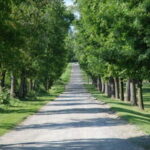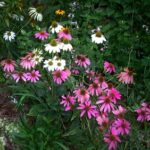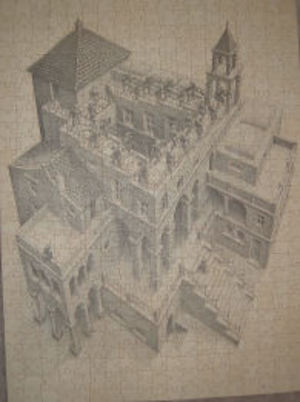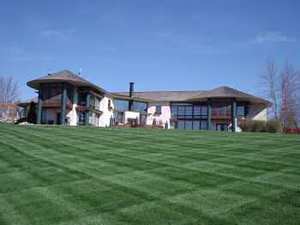Do you have an area that needs some tall plants, but you can’t use shrubs there? A wall that needs some drama against it, but snow falls from the roof and would break woody plants in winter? A driveway that needs a screen along it, but snow plowing into the area would kill evergreens? Tall herbaceous perennials are what you need. They die to the ground in winter and won’t suffer from ice and snow, but come up rapidly in spring and grow to heights that we don’t tend to associate with non-woody plants.
Delphiniums are the showiest tall perennials- possibly the showiest perennials, period. The New Zealand hybrids, the Round Table series, and most of the other D. elatum types (except the Connecticut Yankee group) are all 6 to 8 feet tall and can become quite wide with several stalks. They need rich, well drained soil and a lot of balanced fertilizer to do all that growing and blooming. Their only drawback for screening purposes is that after they bloom, you must cut the stalk down. They will bloom again in late summer, but this time they will only be about 4′ tall. Delphiniums prefer a cool climate; in hot areas, they will be short lived plants. Their most stunning color is blue, one of the clearest blues around. They also come in deep purple, lavender, white and shades of pink. They absolutely need staking.
Hollyhocks are similar to delphiniums in build. Usually classed as biennials, I have had them last for 3 or more years before the main plant dies off. Most do not bloom their first year. They will not only seed themselves but young plants will appear at the base of the main one. This ensures blooms for every year after the first one. Hollyhocks can exceed 10′ in height if well fed, but aren’t as wide as delphiniums. They can be planted as close as 1′ apart. Be prepared to treat them for fungus problems if you live in an area where those are a problem, especially rust. Hollyhocks come in most warm colors, along with white, black (dark maroon) and burgundy shades; they also are available as both singles and doubles.
Macleya is a plant that is unfamiliar to most people but causes an “Oh, Wow!” when they see one. Books say it’s 8′ tall, but mine regularly get at least 10′. The large, scalloped leaves are gray-green above and silvery white underneath. At the top of the stem, a 2 to 3 foot plume appears, peachy in color. Later this bloom turns to seeds, which look like little drops of blood when lit from behind. The stems are massive, hollow things like bamboo. Listed in some sources as invasive, it’s been oddly well behaved for me. No running roots and only a few seedlings here and there. I have no idea why.
Most digitalis (foxglove) plants grow only 3 feet tall, but the Excelsior Hybrids grow up to 5. These are a D. purpurea type, in the usual range of pinks, white and pinky-purple. These make a nice, dense planting with their furry leaves and bloom for a couple of months in summer. Only biennials, they will seed themselves nicely. Taking sun to part shade, they are very easy to please plants. They do not require staking. Be careful when kids or pets are around them as they are poisonous.
Bamboo is the ultimate screen plant (alive in your garden or dead woven into a curtain), but in most areas it fails in the ‘dies to the ground’ category. But up in the north it will do just this. Most varieties won’t survive in the cold, but ‘Golden Groove’ does. It grows 4-7′ tall with canes suitable for fishing poles -indeed, ‘fishing pole bamboo’ is a common name for it. This is a variety that runners, but it doesn’t do it very fast up here, increasing rather slowly. If you’re concerned you can plant it with a barrier around it. The runners don’t go very deep.
Joe Pye Weed (Eupatorium maculatum) gets 6′ tall and is dense and thick. It blooms in late summer with purplish-pink heads of flowers. There is a variety called ‘Chocolate’ that has very dark stems and leaves. It is a marvelous plant, taking almost no care, accepting of some shade and being very dramatic looking with that color. All it asks is steady moisture and it’s happy. Great with some dark leaved heucheras at its feet.
Monkshood (Aconitum, Wolfs Bane) is one of my favorite plants, and not just because of its name. Related to delphiniums, the leaves are deeply incised rather than palmate. The flowers, in white, purple or-best of all-purple and white bicolor, climb spires up to 6′ and are shaped like little helmets. I have never had to stake this plant. Another late bloomer, it is poisonous to the point of being a problem if you get the sap into an open cut.
Want tall bulbs? The trumpet and aurealian lilies grow 4 to 6′ and are very fragrant- one stem will fill a small house with aroma! They definitely need staking from an early stage or the weight of the flower buds will break the stems before they can even bloom. While not good for screening, they make great background plants. Put shorter plants in front of them to hide their skinny stems but do not crowd them. Lilies like to have good air circulation. They also need good drainage to prevent rot. Feed them with bulb food every year and they’ll give you year after year of pleasure, slowly increasing. If you cut them to take indoors, cut as close to the top as you can and still get a useable stem. If you cut any lily too far down, you risk weakening the plant and not having it bloom next year.
None of these plants take special care other than some staking, but that staking is important, especially if the plant is in the open instead of against a wall or fence. An unsupported tall plant in a windy area may need to be tied in several places up its length to keep it still. Delphiniums are very bad for falling over and snapping due to the weight of their blossom spikes. In my area they do their first, tall, bloom about the time that we get heavy storms which invariably break them if they aren’t prepared. Macleya usually only needs staking if it’s in part shade. Every hollyhock must be evaluated on its own; I’ve had some grow to 10′ with no staking and had some 4 footers come crashing down. Despite the nuisance factor, staking needs only be done once a year and is not an onerous duty.




